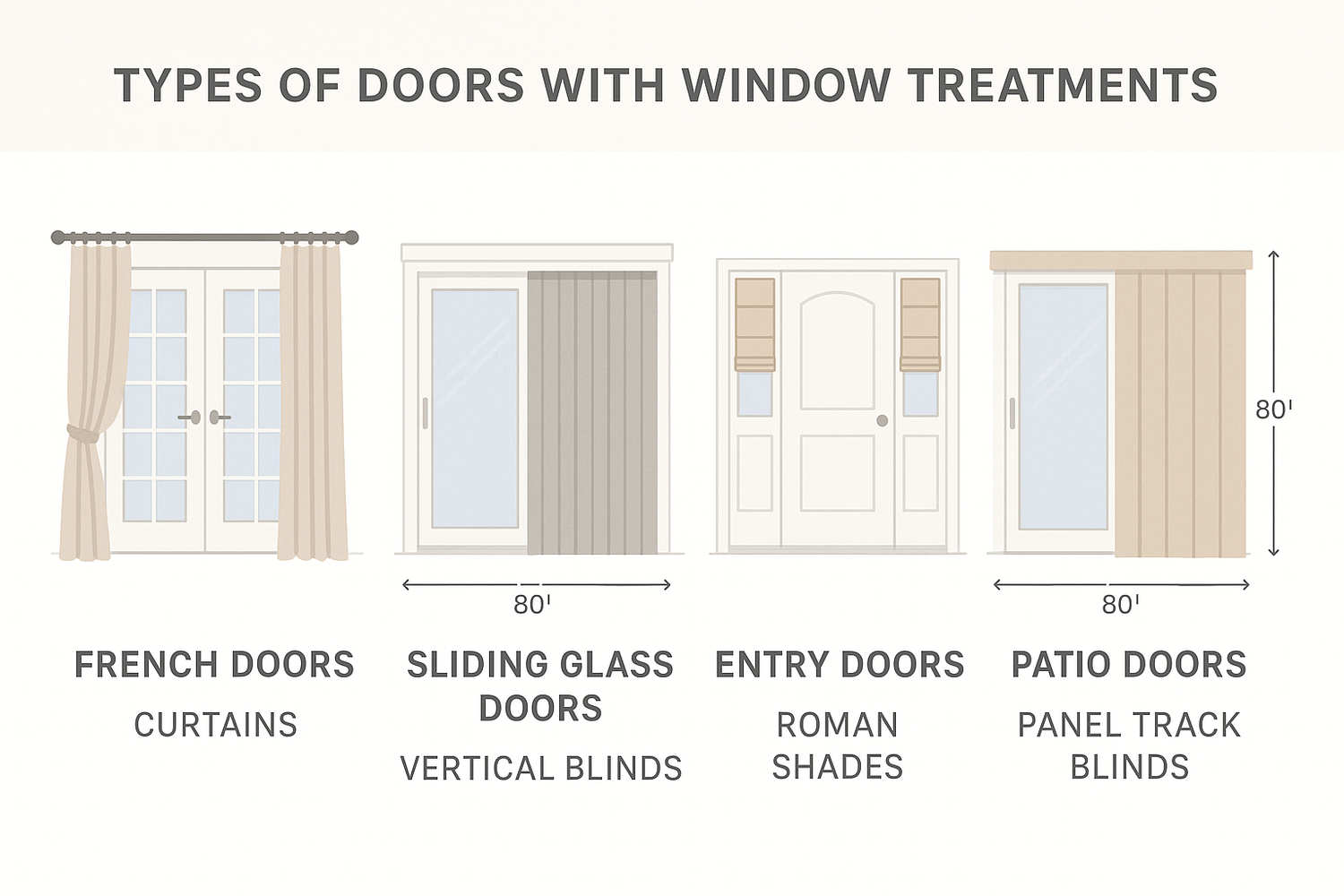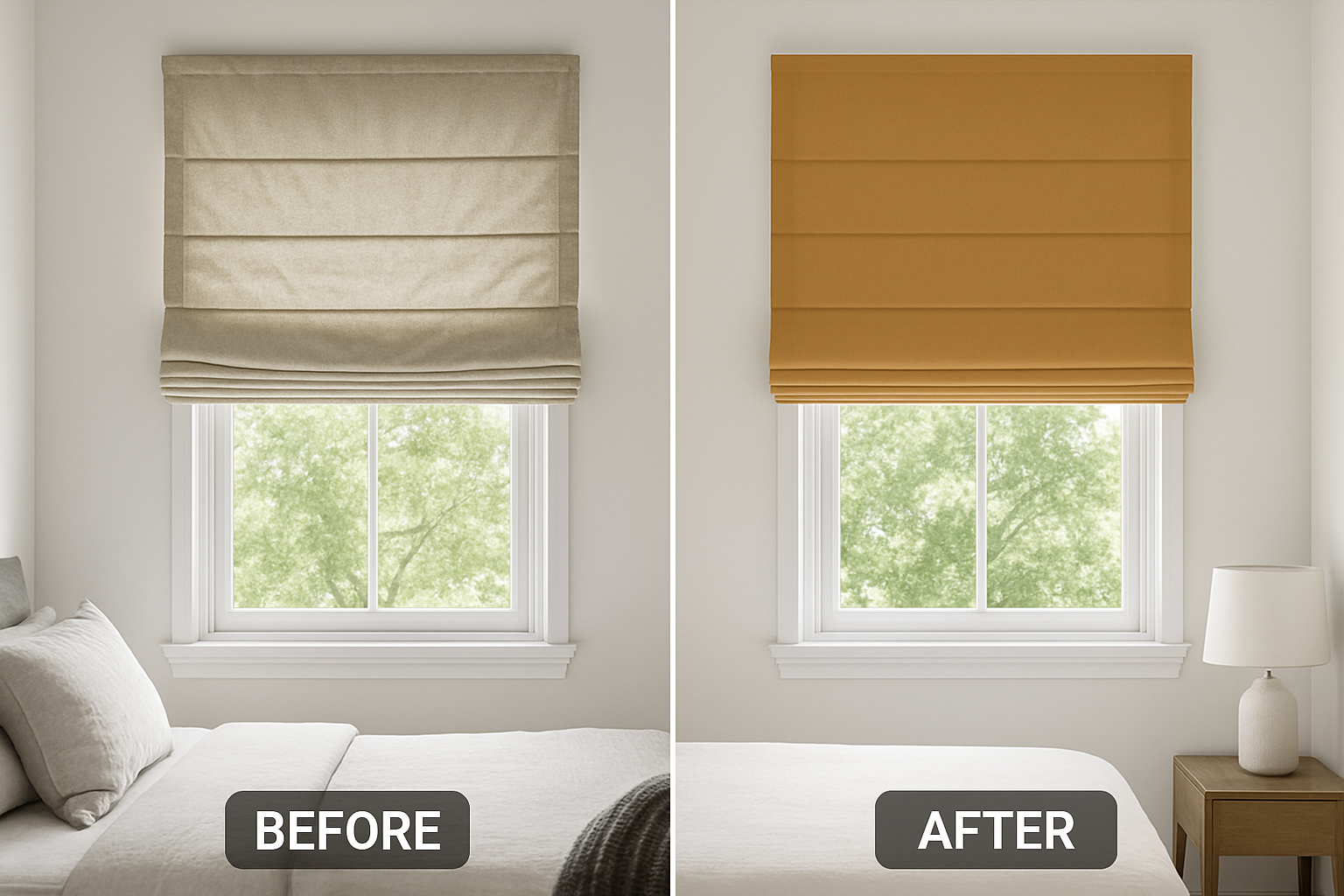Installing window treatments on doors presents unique challenges that differ significantly from standard window installations. Whether you're dealing with French doors, sliding glass doors, entry doors with sidelights, or specialty door configurations, this comprehensive guide will walk you through every step of the process to achieve professional results.

Understanding Door-Specific Installation Challenges
Door installations require special consideration because doors move, creating dynamic stress on mounting hardware. Unlike static windows, door-mounted treatments must accommodate opening and closing motions while maintaining their functionality and appearance.
Key Factors for Door Installations:
- Movement tolerance: Treatments must not interfere with door operation
- Weight distribution: Door frames require different mounting strategies than wall studs
- Clearance requirements: Adequate space for both door swing and treatment operation
- Hardware compatibility: Door materials demand specific fastener types
Essential Tools and Materials for Door Installations
Success starts with having the right tools and materials. Door installations often require specialized hardware that differs from standard window treatment mounting systems.

Required Tools:
| Tool | Purpose | Door Type | Critical Features |
|---|---|---|---|
| Drill with bits | Creating mounting holes | All doors | Variable speed, multiple bit sizes |
| Level (24-inch minimum) | Ensuring straight installation | All doors | Magnetic base helpful for metal doors |
| Measuring tape | Accurate measurements | All doors | Minimum 12-foot length |
| Stud finder | Locating door frame structure | Wood doors | Edge-finding capability |
| Magnetic base | Temporary mounting aid | Metal doors | Strong hold, removable |
Hardware Selection by Door Material:
- Wood doors: Wood screws, 2.5-3 inches long for solid doors
- Metal doors: Self-tapping screws or magnetic mounting systems
- Fiberglass doors: Specialized composite screws with pre-drilling
- Glass doors: Adhesive mounts or frame-only mounting
French Door Installation Methods
French doors are among the most challenging door types for window treatment installation due to their dual-panel design and swing operation. However, with the right approach, they can accommodate beautiful and functional treatments.
Method 1: Individual Panel Treatments
Installing separate treatments on each door panel provides maximum flexibility and maintains the doors' elegant proportions.
Step-by-Step Process:
- Measure each panel separately: Account for any size variations between panels
- Mark bracket positions: Position 2-3 inches from panel edges, ensuring door clearance
- Pre-drill pilot holes: Prevent wood splitting and ensure accurate placement
- Install brackets: Use appropriate screws for door thickness and material
- Test door operation: Ensure treatments don't bind or interfere with opening
Method 2: Unified Treatment System
A single treatment spanning both doors creates a cohesive look but requires careful planning for door operation.
Installation Considerations:
- Mount above door frame to avoid interference
- Extend treatment 4-6 inches beyond door width
- Use center support bracket for treatments over 60 inches
- Consider split-draw operation for easy door access
Sliding Glass Door Solutions
Sliding glass doors present unique opportunities for window treatments due to their large size and track operation. The key is selecting treatments that complement rather than compete with the door's sliding mechanism.
Vertical Blind Installation
Vertical blinds are the classic choice for sliding doors, offering excellent light control and easy operation.
Installation Process:
- Determine mount type: Inside mount for recessed tracks, outside mount for maximum coverage
- Install head rail: Use heavy-duty brackets rated for the blind's weight
- Adjust vane spacing: Ensure smooth operation without binding
- Test draw operation: Verify vanes stack properly without interfering with door
Panel Track Systems
Modern panel track systems offer a sleek, contemporary alternative to traditional vertical blinds.
Advantages of Panel Tracks:
| Feature | Benefit | Best Use Case |
|---|---|---|
| Large fabric panels | Unobstructed view when open | Scenic views, patios |
| Smooth operation | Easy one-hand operation | Frequent use doors |
| Customizable fabrics | Perfect design coordination | Designer interiors |
| Minimal stack space | Maximum glass exposure | Small rooms, limited wall space |
Entry Door and Sidelight Treatments
Entry doors with sidelights require careful treatment selection to maintain security, privacy, and curb appeal while accommodating the door's primary function.
Sidelight-Specific Considerations:
- Security concerns: Treatments should not compromise door security features
- Weather resistance: Entry door treatments face exterior elements
- Privacy needs: Balance visibility with privacy requirements
- Aesthetic coordination: Treatments should complement exterior design
Installation Methods for Sidelights:
Tension Rod Installation:
Ideal for narrow sidelight windows, tension rods require no drilling and offer easy seasonal changes.
- Measure interior width of sidelight frame
- Select tension rod 1/2 inch larger than measurement
- Position rod at desired height within frame
- Extend rod until snug fit achieved
- Test stability before hanging treatment
Magnetic Mounting Systems:
Perfect for metal doors and frames, magnetic systems provide strong hold without permanent installation.
Magnetic Installation Benefits:
| Advantage | Description | Ideal Situation |
|---|---|---|
| No drilling required | Preserves door integrity | Rental properties, new doors |
| Easy removal | Seasonal or temporary use | Holiday decorations, weather protection |
| Strong hold | Supports substantial weight | Heavy fabrics, multiple layers |
| Repositionable | Adjust height and position easily | Experimental installations, changing needs |
Specialty Door Configurations
Unique door configurations require creative solutions that maintain functionality while achieving desired aesthetic and practical outcomes.
Bi-Fold Door Treatments
Bi-fold doors present installation challenges due to their folding mechanism and track requirements.
Installation Strategies:
- Above-track mounting: Install treatments above the door track to avoid interference
- Individual panel approach: Treat each panel separately for maximum flexibility
- Bypass systems: Use treatments that slide past the door opening
Pocket Door Solutions
Pocket doors disappear into wall cavities, requiring treatments that accommodate this unique operation.
Key Considerations:
- Mount treatments on wall above pocket opening
- Ensure adequate clearance for door operation
- Consider split-draw systems for easy access
- Plan for treatment stack-back space
Professional Installation Techniques
Achieving professional results requires attention to detail and proper technique throughout the installation process.
Measurement Best Practices:
- Multiple measurements: Measure width and height in three locations
- Account for door swing: Ensure adequate clearance for full door operation
- Consider treatment stack-back: Plan space for treatments when fully open
- Check for square: Verify door frames are square and level
Installation Sequence:
| Step | Action | Critical Points | Common Mistakes |
|---|---|---|---|
| 1 | Mark bracket positions | Use level, measure from consistent reference points | Eyeballing positions, inconsistent measurements |
| 2 | Pre-drill holes | Use correct bit size, maintain perpendicular angle | Wrong bit size, angled holes |
| 3 | Install brackets | Don't over-tighten, ensure level installation | Stripped screws, crooked mounting |
| 4 | Mount treatment | Test operation before final adjustment | Skipping operation test |
| 5 | Final adjustments | Fine-tune level, operation, and appearance | Accepting "good enough" results |
Troubleshooting Common Installation Problems
Even experienced installers encounter challenges. Knowing how to address common problems saves time and ensures professional results.
Problem: Treatment Binds During Operation
Causes and Solutions:
- Insufficient clearance: Adjust bracket position or treatment size
- Crooked installation: Re-level brackets and reinstall
- Door frame interference: Switch to outside mount or adjust positioning
- Hardware malfunction: Inspect and replace defective components
Problem: Uneven Appearance
Diagnostic Steps:
- Check bracket level with precision level
- Verify consistent mounting height
- Inspect treatment for manufacturing defects
- Confirm proper bracket spacing
Maintenance and Long-Term Care
Door-mounted treatments require specific maintenance approaches due to the dynamic stress of door operation.
Regular Maintenance Schedule:
| Frequency | Task | Focus Areas | Tools Needed |
|---|---|---|---|
| Monthly | Hardware inspection | Brackets, screws, mounting points | Screwdriver, level |
| Quarterly | Operation testing | Smooth movement, proper alignment | None |
| Seasonally | Deep cleaning | Fabric, hardware, tracks | Vacuum, cleaning supplies |
| Annually | Complete inspection | All components, wear patterns | Full tool kit |
Signs Requiring Immediate Attention:
- Loose or sagging treatments
- Difficulty operating door or treatment
- Visible wear on mounting hardware
- Gaps or misalignment in treatment position
Cost Analysis and Budget Planning
Understanding the total cost of door window treatment installation helps in making informed decisions and budget planning.
Cost Factors by Door Type:
| Door Type | Treatment Cost Range | Installation Complexity | Professional Installation Cost |
|---|---|---|---|
| French Doors | $150-600 per door | Moderate to High | $100-250 |
| Sliding Glass | $200-800 | Moderate | $150-300 |
| Entry with Sidelights | $100-400 | Low to Moderate | $75-150 |
| Specialty Doors | $250-1000+ | High | $200-500 |
When to Choose Professional Installation
While many door window treatment installations are DIY-friendly, certain situations warrant professional expertise.
Professional Installation Recommended For:
- High-value treatments: Expensive custom treatments justify professional installation
- Complex door configurations: Unusual shapes, multiple panels, or specialty hardware
- Structural concerns: Older doors, questionable frame integrity, or load-bearing considerations
- Warranty requirements: Some manufacturers require professional installation for warranty coverage
Future-Proofing Your Installation
Planning for future needs ensures your window treatment investment remains valuable and functional over time.
Considerations for Long-Term Success:
- Expandability: Choose systems that can accommodate additional panels or modifications
- Technology integration: Consider motorization compatibility for future upgrades
- Style flexibility: Select neutral hardware that works with changing decor
- Maintenance accessibility: Ensure treatments can be easily cleaned and serviced
Mastering Door Window Treatment Installation
Successfully installing window treatments on doors requires understanding the unique challenges each door type presents and applying appropriate techniques and materials. From French doors requiring individual panel consideration to sliding glass doors demanding specialized track systems, each installation type has specific requirements for optimal results.
The key to success lies in thorough planning, proper tool selection, accurate measurement, and attention to detail throughout the installation process. Whether you choose to tackle the project yourself or hire professionals, understanding these principles ensures you'll achieve beautiful, functional results that enhance your home's comfort and style.
Ready to Transform Your Doors?
Explore our comprehensive collection of door-specific window treatments, featuring solutions for every door type and style preference. Our expert installation team is ready to help you achieve professional results that will serve you beautifully for years to come.
Transform your doors from functional necessities into stunning design elements with the perfect window treatments.









Leave a comment
This site is protected by hCaptcha and the hCaptcha Privacy Policy and Terms of Service apply.